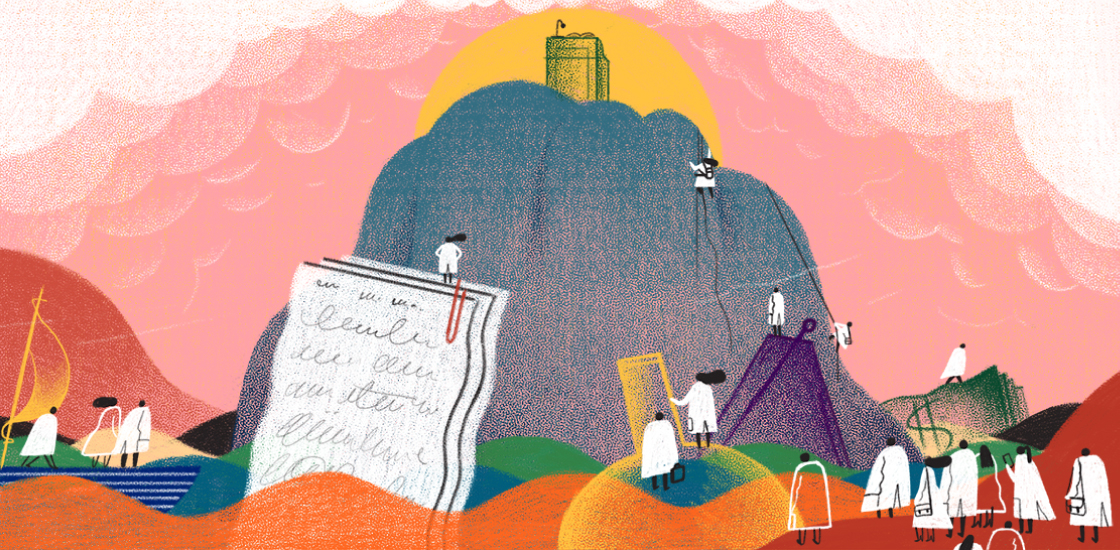In scramble for science faculty jobs, timing is key
Parlaying a postdoc into one of a dwindling number of faculty positions takes hard work and sheer luck.

Clare Harrop was a few weeks pregnant in October 2015 when she began applying to faculty positions. She was partway through her second postdoctoral stint, in Brian Boyd’s lab at the University of North Carolina at Chapel Hill. She had eight papers under her belt and another eight in progress. She sent out applications for 14 positions and landed four interviews — but received not a single offer.
Harrop began the application process all over again this October, now with 11 published papers. She is also applying for funding that she could take with her to a new position, something that might make her more “marketable,” she says.
Filling out the applications is practically a full-time job in and of itself, Harrow says, to be accomplished in addition to juggling her work for her principal investigator (PI) Boyd and the demands of being a new mother. “I spend most of my evenings working on stuff because there’s not just enough time in the day to do my own research, my PI’s research, apply for jobs and write papers,” Harrop says. “Knowing where to focus that time is hard: Do I focus on writing grants, or do I focus on writing papers?”
Harrop plans to submit an application for an independent grant early next year, but she may have to wait an entire year for the result. Applications for faculty positions are generally due in October for start dates the following year. This means Harrop could spend two more years as a postdoc before being able to use the grant as leverage for a job.
The circumstances leave Harrop and her family in an uncertain situation, to be upended if a job elsewhere in the country comes along. Harrop’s husband, an architect, will have to find work in a new city; when he moved to North Carolina for Harrop’s current fellowship, it took him six months to find a permanent job.
“That uncertainty is quite hard — at some point, financially you want to be in a better position,” Harrop says. “You don’t want to be treading water for such a long time.”
Treading water has become the norm for the thousands of postdocs like Harrop. A postdoctoral fellowship was once a three-year stint between finishing graduate school and starting a lab. But the scarcity of academic positions has bloated the low-paying position to six or even seven years. Having multiple postdoc positions is now the rule rather than the exception.
Some refer to this phenomenon as the ‘broken pipeline.’ Others call it a pyramid, in which a single lab chief has dozens of postdocs fueling her lab’s progress. There are not nearly enough faculty jobs for all of those fellows.
Too little time:
Megan Dennis is one of the success stories. Dennis says she knew that it would take not one but multiple prestigious publications to earn her a faculty position, so she dedicated her first few years in the lab entirely to work.
“There are so few positions, and we’re all competing so hard for these positions; we feel like we have to do extreme work to be able to get there,” says Dennis, assistant professor of biochemistry and molecular medicine at the University of California, Davis.
Dennis had her first child toward the end of her postdoctoral fellowship, traveling to grueling faculty interviews with her 6-week-old infant in tow. She isn’t sure she would have been able to land an interview in the first place if she’d had her son earlier in her career. “I was prepared to work that hard, and in my head it was something I had to do,” she says. “But if I had had my family and my son then it would have been really challenging; I think it would have been almost impossible.”
The application cycle for faculty jobs generally begins in October. The expertise sought for these positions — and the scientific background of the postdocs competing for them — tends to go in cycles.
Holly Stessman was a postdoc until October in Evan Eichler’s lab at the University of Washington in Seattle. She is now assistant professor of pharmacology at Creighton University School of Medicine in Omaha, Nebraska. She was fortunate that several jobs for geneticists became available the year she sent out her first applications. The previous year had been particularly “tight,” she says. In fact, Stessman’s colleagues advised her to wait and postpone her application an entire year if it seemed as if there were too many geneticists on the market.
The institutions also tend to look for candidates with a specific skill set each year, says Nicolas Renier, who was a postdoc in Marc Tessier-Lavigne’s lab at Rockefeller University in New York. “Every year, there are very few candidates that are going to be the hot candidates of the year, that are going to get all the interviews, that are going to have all the offers. It means that all the others are going to be stuck in limbo,” he says.
Renier says he is relieved that his research focus — rendering the brain transparent to obtain clear pictures of its inner workings — has been especially popular the past few years. He accepted a position this month as group leader (the European equivalent to assistant professor) at the Brain and Spine Institute in Paris. But he could not have predicted this nearly five years ago.
“When I started my postdoc, my goal was not to eventually get a faculty position, because I felt it was too random. I just wanted to do cool stuff that I found interesting,” he says. “I got lucky.”
Tony Filiano, a postdoc in Jonathan Kipnis’ lab at the University of Virginia in Charlottesville, tries not to worry about his career prospects and instead stays focused on the work at hand. “Day to day you just try to do great science and hope that all the pieces fall together when that time comes,” he says. “I don’t know how much more I can do other than that.”
Regardless of their status, most young scientists agree on one thing: They wouldn’t trade the years of working long hours for low pay for a career outside of science.
“I absolutely love what I do,” Harrop says. “I just got some amazing data I was really, really excited about. If I didn’t get that rush, I wouldn’t do it. So I don’t mind too much — but it is pretty depressing.”
Recommended reading

Glutamate receptors, mRNA transcripts and SYNGAP1; and more

Among brain changes studied in autism, spotlight shifts to subcortex
Explore more from The Transmitter

AI-assisted coding: 10 simple rules to maintain scientific rigor

Frameshift: Shari Wiseman reflects on her pivot from science to publishing

